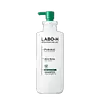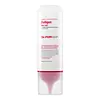What's inside
What's inside
 Key Ingredients
Key Ingredients

 Benefits
Benefits

 Concerns
Concerns

 Ingredients Side-by-side
Ingredients Side-by-side

Water
Skin ConditioningSodium Cocoyl Isethionate
CleansingDisodium Laureth Sulfosuccinate
CleansingLauryl Betaine
CleansingGlyceryl Stearate
EmollientTrihydroxystearin
Skin ConditioningPolyquaternium-10
Caffeine
Skin ConditioningCetyl Alcohol
EmollientDicaprylyl Ether
EmollientSodium Benzoate
MaskingSodium Salicylate
PreservativeMentha Piperita Oil
MaskingMenthol
MaskingCitric Acid
BufferingCaprylic/Capric Triglyceride
MaskingCaprylyl Glycol
EmollientIllicium Verum Fruit/Seed Oil
MaskingRosmarinus Officinalis Leaf Oil
MaskingDextrin
AbsorbentJuniperus Virginiana Oil
MaskingTetrasodium EDTA
Mentha Arvensis Leaf Oil
MaskingEucalyptus Globulus Leaf Oil
PerfumingOcimum Basilicum Oil
MaskingAnthemis Nobilis Flower Oil
MaskingViola Odorata Leaf Extract
MaskingLactobacillus Ferment Lysate
Skin ConditioningGlycerin
HumectantCamellia Sinensis Seed Extract
HumectantTocopherol
AntioxidantCeramide NP
Skin ConditioningHydrogenated Lecithin
EmulsifyingPhytosphingosine
Skin ConditioningBiotin
AntiseborrhoeicWater, Sodium Cocoyl Isethionate, Disodium Laureth Sulfosuccinate, Lauryl Betaine, Glyceryl Stearate, Trihydroxystearin, Polyquaternium-10, Caffeine, Cetyl Alcohol, Dicaprylyl Ether, Sodium Benzoate, Sodium Salicylate, Mentha Piperita Oil, Menthol, Citric Acid, Caprylic/Capric Triglyceride, Caprylyl Glycol, Illicium Verum Fruit/Seed Oil, Rosmarinus Officinalis Leaf Oil, Dextrin, Juniperus Virginiana Oil, Tetrasodium EDTA, Mentha Arvensis Leaf Oil, Eucalyptus Globulus Leaf Oil, Ocimum Basilicum Oil, Anthemis Nobilis Flower Oil, Viola Odorata Leaf Extract, Lactobacillus Ferment Lysate, Glycerin, Camellia Sinensis Seed Extract, Tocopherol, Ceramide NP, Hydrogenated Lecithin, Phytosphingosine, Biotin
Sodium Chloride
MaskingWater
Skin ConditioningCoco-Betaine
CleansingGlycerin
HumectantSea Salt
AbrasiveSodium Cocoyl Alaninate
Lauryl Betaine
CleansingCocamide Mea
EmulsifyingSodium Lauroyl Glutamate
Alcohol Denat.
AntimicrobialPotassium Cocoate
EmulsifyingPPG-3 Caprylyl Ether
SolventTrehalose
HumectantCaprylyl Glycol
EmollientIsopropyl Myristate
EmollientMenthol
MaskingTrihydroxystearin
Skin ConditioningPolyquaternium-10
Panthenol
Skin ConditioningSalicylic Acid
MaskingSucrose Stearate
EmollientTromethamine
BufferingNiacinamide
SmoothingMenthyl Lactate
MaskingMentha Piperita Oil
MaskingZea Mays Oil
EmulsifyingSodium Benzoate
MaskingCaprylic/Capric Triglyceride
MaskingMelaleuca Alternifolia Leaf Oil
AntioxidantArgania Spinosa Kernel Oil
EmollientCamellia Seed Oil
Carum Carvi Seed Oil
MaskingCarica Papaya Fruit Extract
Skin ConditioningPinus Pinaster Leaf Extract
Skin ConditioningButylene Glycol
Humectant1,2-Hexanediol
Skin ConditioningPolysorbate 80
EmulsifyingLecithin
EmollientCeramide NP
Skin ConditioningMentha Piperita Leaf Extract
Skin ConditioningFreesia Refracta Extract
Skin ConditioningMentha Citrata Leaf Extract
AstringentChamomilla Recutita Extract
Skin ConditioningRosmarinus Officinalis Leaf Extract
AntimicrobialLavandula Angustifolia Extract
Skin ConditioningCaffeine
Skin ConditioningAdenosine
Skin ConditioningBiotin
AntiseborrhoeicPearl Extract
AntioxidantVinca Minor Leaf Extract
Skin ConditioningCentella Asiatica Extract
CleansingEthylhexylglycerin
Skin ConditioningZinc Pyrithione
AntiseborrhoeicZingiber Officinale Root Extract
MaskingSodium Chloride, Water, Coco-Betaine, Glycerin, Sea Salt, Sodium Cocoyl Alaninate, Lauryl Betaine, Cocamide Mea, Sodium Lauroyl Glutamate, Alcohol Denat., Potassium Cocoate, PPG-3 Caprylyl Ether, Trehalose, Caprylyl Glycol, Isopropyl Myristate, Menthol, Trihydroxystearin, Polyquaternium-10, Panthenol, Salicylic Acid, Sucrose Stearate, Tromethamine, Niacinamide, Menthyl Lactate, Mentha Piperita Oil, Zea Mays Oil, Sodium Benzoate, Caprylic/Capric Triglyceride, Melaleuca Alternifolia Leaf Oil, Argania Spinosa Kernel Oil, Camellia Seed Oil, Carum Carvi Seed Oil, Carica Papaya Fruit Extract, Pinus Pinaster Leaf Extract, Butylene Glycol, 1,2-Hexanediol, Polysorbate 80, Lecithin, Ceramide NP, Mentha Piperita Leaf Extract, Freesia Refracta Extract, Mentha Citrata Leaf Extract, Chamomilla Recutita Extract, Rosmarinus Officinalis Leaf Extract, Lavandula Angustifolia Extract, Caffeine, Adenosine, Biotin, Pearl Extract, Vinca Minor Leaf Extract, Centella Asiatica Extract, Ethylhexylglycerin, Zinc Pyrithione, Zingiber Officinale Root Extract
 Reviews
Reviews

Ingredients Explained
These ingredients are found in both products.
Ingredients higher up in an ingredient list are typically present in a larger amount.
Biotin is a B vitamin that is naturally produced by our bodies. It is also called Vitamin H.
Our bodies use biotin in the metabolism process. It also helps our bodies use enzymes and move nutrients around. A biotin deficiency can lead to brittle hair and nails.
More research is needed on applying biotin topically. However, taking biotin orally has been shown to help nourish the skin, hair, and nails. They play a role in forming skin-hydrating fatty acids.
Biotin is water-soluble. It can be found in foods such as fish, eggs, dairy, nuts, and meat. Vitamin H stands for "haar" and "haut". These are the German words for hair and skin.
Learn more about BiotinCaffeine is most associated with coffee, tea, and cacao. In skincare, it helps with calming inflammation and is rich in antioxidants.
While caffeine is used to treat cellulite and and dark circles, further studies are needed to prove this. It has been believed to help with these skin conditions due to its ability to dilate blood vessels and increase blood flow.
Some studies are looking into caffeine's ability to protect against UV rays.
Learn more about CaffeineThis ingredient is an emollient, solvent, and texture enhancer. It is considered a skin-softener by helping the skin prevent moisture loss.
It helps thicken a product's formula and makes it easier to spread by dissolving clumping compounds.
Caprylic Triglyceride is made by combining glycerin with coconut oil, forming a clear liquid.
While there is an assumption Caprylic Triglyceride can clog pores due to it being derived from coconut oil, there is no research supporting this.
Learn more about Caprylic/Capric TriglycerideCaprylyl Glycol is a humectant and emollient, meaning it attracts and preserves moisture.
It is a common ingredient in many products, especially those designed to hydrate skin. The primary benefits are retaining moisture, skin softening, and promoting a healthy skin barrier.
Though Caprylyl Glycol is an alcohol derived from fatty acids, it is not the kind that can dry out skin.
This ingredient is also used as a preservative to extend the life of products. It has slight antimicrobial properties.
Learn more about Caprylyl GlycolCeramide NP is a type of ceramide and formally known as ceramide 3.
Ceramides are intercellular lipids naturally found in our skin that bonds dead skin cells together to create a barrier. They are known for their ability to hold water and thus are a great ingredient for dry skin.
Ceramides are an important building block for our skin barrier. A stronger barrier helps the skin look more firm and hydrated. By bolstering the skin ceramides act as a barrier against irritating ingredients. This can help with inflammation as well.
If you would like to eat ceramides, sweet potatoes contain a small amount.
Read more about other common types of ceramides here:
Ceramide AP
Ceramide EOP
Glycerin is already naturally found in your skin. It helps moisturize and protect your skin.
A study from 2016 found glycerin to be more effective as a humectant than AHAs and hyaluronic acid.
As a humectant, it helps the skin stay hydrated by pulling moisture to your skin. The low molecular weight of glycerin allows it to pull moisture into the deeper layers of your skin.
Hydrated skin improves your skin barrier; Your skin barrier helps protect against irritants and bacteria.
Glycerin has also been found to have antimicrobial and antiviral properties. Due to these properties, glycerin is often used in wound and burn treatments.
In cosmetics, glycerin is usually derived from plants such as soybean or palm. However, it can also be sourced from animals, such as tallow or animal fat.
This ingredient is organic, colorless, odorless, and non-toxic.
Glycerin is the name for this ingredient in American English. British English uses Glycerol/Glycerine.
Learn more about GlycerinLauryl Betaine is a surfactant. It helps cleanse your skin by gathering oil, dirt, and other pollutants to be rinsed away.
Mentha Piperita Oil is the volatile oil obtained from the whole plant of the Peppermint plant.
It can be used to add a fresh scent to products.
Peppermint oil may cause skin sensitivity and redness due to its menthol content. Menthol also has a cooling effect (like your toothpaste).
Learn more about Mentha Piperita OilMenthol is a compound found in mint plants, such as peppermint. In its pure form, it is a clear crystalline substance.
Menthol is known for its cooling sensation; however, the cooling is actually from your skin being sensitized. Menthol can worsen rosacea. We recommend speaking with a professional if you have concerns.
Menthol also has antimicrobial properties.
Learn more about MentholPolyquaternium-10 is an ammonium salt of hydroxyethylcellulose. It is a white and granular powder used as a film-former and anti-static agent.
This ingredient is commonly found in hair conditioning products. According to a manufacturer, its positive charge makes it great for absorbing hair proteins. The manufacturer also states this ingredient helps with curl retention.
For haircare friends: this ingredient is not a silicone.
Learn more about Polyquaternium-10Sodium Benzoate is a preservative. It's used in both cosmetic and food products to inhibit the growth of mold and bacteria. It is typically produced synthetically.
Both the US FDA and EU Health Committee have approved the use of sodium benzoate. In the US, levels of 0.1% (of the total product) are allowed.
Sodium benzoate works as a preservative by inhibiting the growth of bacteria inside of cells. It prevents the cell from fermenting a type of sugar using an enzyme called phosphofructokinase.
It is the salt of benzoic acid. Foods containing sodium benzoate include soda, salad dressings, condiments, fruit juices, wines, and snack foods.
Studies for using ascorbic acid and sodium benzoate in cosmetics are lacking, especially in skincare routines with multiple steps.
We always recommend speaking with a professional, such as a dermatologist, if you have any concerns.
Learn more about Sodium BenzoateThis ingredient comes from Hydroxystearic Acid, a fatty acid, and glycerin. It is used to thicken oils.
Due to its fatty acid content, it is a natural emollient.
Creating trihydroxystearin involves using a chemical reaction between hydrogen and castor oil.
This ingredient may not be Malassezia folliculitis safe.
Learn more about TrihydroxystearinWater. It's the most common cosmetic ingredient of all. You'll usually see it at the top of ingredient lists, meaning that it makes up the largest part of the product.
So why is it so popular? Water most often acts as a solvent - this means that it helps dissolve other ingredients into the formulation.
You'll also recognize water as that liquid we all need to stay alive. If you see this, drink a glass of water. Stay hydrated!
Learn more about Water